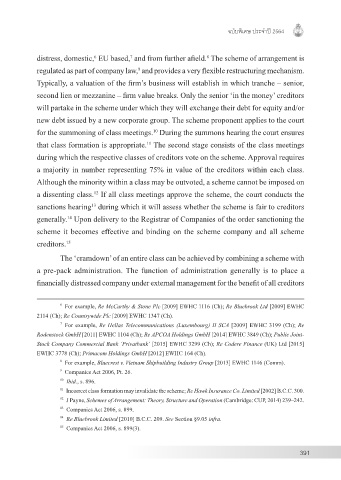Page 393 - วารสารกฎหมาย ศาลอุทธรณ์คดีชํานัญพิเศษ
P. 393
ฉบับพิเศษ ประจำ�ปี 2564
distress, domestic, EU based, and from further afield. The scheme of arrangement is
6
8
7
regulated as part of company law, and provides a very flexible restructuring mechanism.
9
Typically, a valuation of the firm’s business will establish in which tranche – senior,
second lien or mezzanine – firm value breaks. Only the senior ‘in the money’ creditors
will partake in the scheme under which they will exchange their debt for equity and/or
new debt issued by a new corporate group. The scheme proponent applies to the court
for the summoning of class meetings. During the summons hearing the court ensures
10
that class formation is appropriate. The second stage consists of the class meetings
11
during which the respective classes of creditors vote on the scheme. Approval requires
a majority in number representing 75% in value of the creditors within each class.
Although the minority within a class may be outvoted, a scheme cannot be imposed on
a dissenting class. If all class meetings approve the scheme, the court conducts the
12
sanctions hearing during which it will assess whether the scheme is fair to creditors
13
generally. Upon delivery to the Registrar of Companies of the order sanctioning the
14
scheme it becomes effective and binding on the scheme company and all scheme
creditors. 15
The ‘cramdown’ of an entire class can be achieved by combining a scheme with
a pre-pack administration. The function of administration generally is to place a
financially distressed company under external management for the benefit of all creditors
6 For example, Re McCarthy & Stone Plc [2009] EWHC 1116 (Ch); Re Bluebrook Ltd [2009] EWHC
2114 (Ch); Re Countrywide Plc [2009] EWHC 1347 (Ch).
7 For example, Re Hellas Telecommunications (Luxembourg) II SCA [2009] EWHC 3199 (Ch); Re
Rodenstock GmbH [2011] EWHC 1104 (Ch); Re APCOA Holdings GmbH [2014] EWHC 3849 (Ch); Public Joint-
Stock Company Commercial Bank ‘Privatbank’ [2015] EWHC 3299 (Ch); Re Codere Finance (UK) Ltd [2015]
EWHC 3778 (Ch); Primacom Holdings GmbH [2012] EWHC 164 (Ch).
8 For example, Bluecrest v. Vietnam Shipbuilding Industry Group [2013] EWHC 1146 (Comm).
9 Companies Act 2006, Pt. 26.
10 Ibid., s. 896.
11 Incorrect class formation may invalidate the scheme; Re Hawk Insurance Co. Limited [2002] B.C.C. 300.
12 J Payne, Schemes of Arrangement: Theory, Structure and Operation (Cambridge: CUP, 2014) 239–242.
13 Companies Act 2006, s. 899.
14 Re Bluebrook Limited [2010] B.C.C. 209. See Section §9.05 infra.
15 Companies Act 2006, s. 899(3).
391

